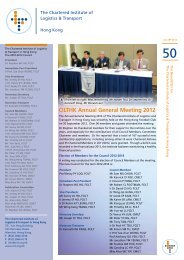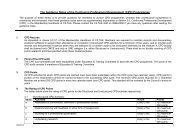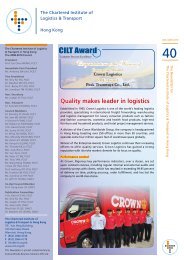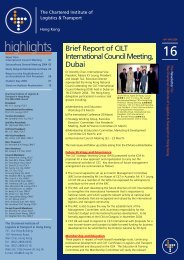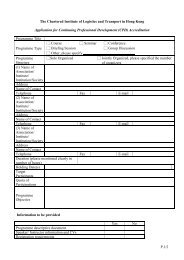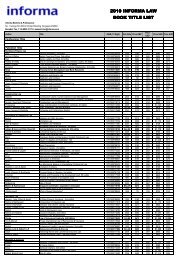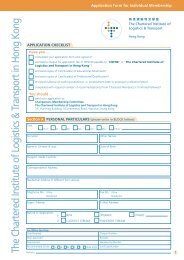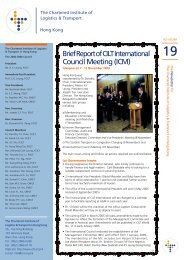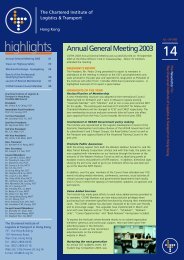CIT WORLD 8 TEMPLATE - The Chartered Institute of Logistics and ...
CIT WORLD 8 TEMPLATE - The Chartered Institute of Logistics and ...
CIT WORLD 8 TEMPLATE - The Chartered Institute of Logistics and ...
You also want an ePaper? Increase the reach of your titles
YUMPU automatically turns print PDFs into web optimized ePapers that Google loves.
18<br />
CILTWorld issue 9<br />
MULTI-MODAL<br />
Canadian Expressway —<br />
‘a passenger service for trucks’<br />
by Alan Marshall<br />
WHILE a £10 billion project strives to win approval in<br />
the UK to take up to 10,000 lorries a day <strong>of</strong>f Britain’s<br />
motorways, a Canadian railway is showing the<br />
benefits <strong>of</strong> a similar scheme between Montreal <strong>and</strong><br />
the mid-west USA.<br />
<strong>The</strong> British proposal would see ‘piggy-back’<br />
trains taking lorry trailers from a series <strong>of</strong> depots<br />
to the Channel Tunnel. <strong>The</strong> ‘Central Railway’<br />
route would relieve motorways <strong>of</strong> some five<br />
million lorry journeys a year, its backers claim.<br />
Central Railway would extend beyond the<br />
Channel Tunnel to Lille, in Northern France, <strong>and</strong><br />
is reported to have attracted the support <strong>of</strong> the<br />
French government.<br />
In Canada <strong>and</strong> mid-west America a similar<br />
cross-border scheme is already winning large<br />
volumes <strong>of</strong> ‘piggy-back’ lorry trailers from the<br />
roads. Launched in 2002 by Canadian Pacific<br />
Railway, one <strong>of</strong> Canada’s two railroad giants –<br />
after three years <strong>of</strong> trials <strong>and</strong> £20 million<br />
investment – the service is dubbed Expressway,<br />
with huge trains speeding daily between the<br />
eastern port <strong>of</strong> Montreal (Quebec), Toronto<br />
(Ontario), Windsor (Ontario) <strong>and</strong> Detroit<br />
(Michigan, USA).<br />
CP Rail – which is Canada's second-biggest<br />
railway with a 22,500-kilometre (14,060 mile)<br />
network stretching from Montreal to Vancouver,<br />
<strong>and</strong> into the U.S. Northeast <strong>and</strong> Midwest region<br />
– is also making major investments in new<br />
intermodal rolling stock (see page 19).<br />
Because the Port <strong>of</strong> Montreal is 1,000 miles<br />
along the St Lawrence River inside Canada, more<br />
goods to <strong>and</strong> from mid-west USA travel this way<br />
than via east coast US ports, such as New York.<br />
Montreal now h<strong>and</strong>les more than one million<br />
containers a year – half <strong>of</strong> them coming from, or<br />
going to, locations in the United States.<br />
So successful has been the service , at the time <strong>of</strong><br />
writing Expressway is to extend south to Chicago<br />
(Illinois), <strong>and</strong> in Canada eastwards to Quebec<br />
City. A service from Toronto via Montreal to New<br />
York is also planned.<br />
Each train 1.8km long<br />
Each Expressway train is 2,000 yards long — that’s<br />
nearly one <strong>and</strong> a quarter miles (1.8 km) – <strong>and</strong><br />
operates at 100 km/h (60mph), hauled by three or<br />
four diesel locomotives, depending on their<br />
power. <strong>The</strong> journey between Montreal <strong>and</strong><br />
Toronto takes five hours <strong>and</strong> road hauliers can<br />
book up to a year in advance to get their trailers<br />
on the trains.<br />
All customers negotiate their own prices with<br />
CPR, as there is no regulation <strong>of</strong> costs <strong>and</strong> charges<br />
on Canadian or American railways, but a typical<br />
rate to carry a trailer between Montreal <strong>and</strong><br />
Toronto would be around £200 ($330), CPR<br />
<strong>of</strong>ficials told me.<br />
<strong>The</strong> ‘secret’ <strong>of</strong> CPR’s Expressway operation is the<br />
rapidity with which lorry trailers are loaded onto<br />
the rail wagons <strong>and</strong> the trains are despatched.<br />
Each train is divided into 10-wagon articulated<br />
sections <strong>and</strong> trailers are parked in order for<br />
loading. CPR claims that 95% <strong>of</strong> road tractor<br />
units leave a terminal within 15 minutes <strong>of</strong><br />
delivering their trailers. All paperwork, including<br />
bills <strong>of</strong> lading <strong>and</strong> customs documentation, is<br />
computerised as part <strong>of</strong> the pre-booking<br />
arrangements.<br />
“Expressway is basically a passenger service for<br />
trucks,” said Ray O’Meara, CPR’s general<br />
manager <strong>of</strong> Expressway. “We don’t compete with<br />
truckers because we don’t deal with shippers.<br />
Rather, we are a wholesaler <strong>of</strong> line-haul services<br />
for truckers. What we are saying is that we think<br />
we can help the truck industry become more<br />
pr<strong>of</strong>itable.”<br />
Expressway is also popular with trucking<br />
companies because <strong>of</strong> the growing shortage <strong>of</strong><br />
truck drivers in Canada <strong>and</strong> the USA, where the<br />
industry is attracting fewer recruits each year.<br />
<strong>The</strong> CPR procedure is very efficient, with just two<br />
tractor drivers <strong>and</strong> two supervisors on the ground<br />
being responsible for loading the whole train,<br />
keeping in touch with each other <strong>and</strong> with the<br />
train driver by two-way radio.<br />
After consignments have been delivered to a CPR<br />
terminal, diesel tractor tugs push each trailer up a<br />
portable ramp onto its designated rail wagon. A<br />
support then rises from the floor <strong>of</strong> the wagon to<br />
replace the ‘fifth wheel’ on the tractor unit <strong>and</strong> to<br />
hold the trailer securely in place. <strong>The</strong> trailer’s air<br />
brake lines are detached <strong>and</strong> the tractor tug unit is<br />
removed. <strong>The</strong> loading process takes just one<br />
minute.<br />
Many refrigerated trailers are carried, but no<br />
power supplies are necessary on the train because<br />
<strong>of</strong> the quick loading <strong>and</strong> transit times. Instead<br />
trailers are fully charged to maximum coldness<br />
before departure.<br />
As each 10-wagon set is loaded, it is shunted into<br />
line by the train locomotives until the massive<br />
trainload, 2,000 yards (1.8 km) long, is all coupled<br />
together. Brake tests are done as each section is<br />
coupled to the train so, within a minute or two <strong>of</strong><br />
the last set <strong>of</strong> wagons being hooked up, the train<br />
is ready to head <strong>of</strong>f at 60 mph.



